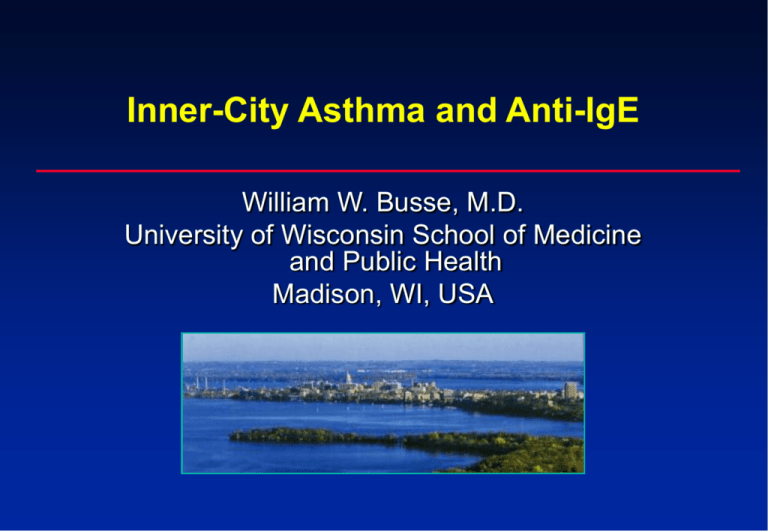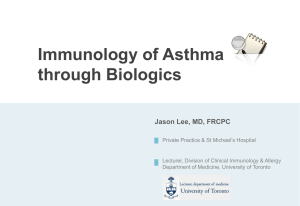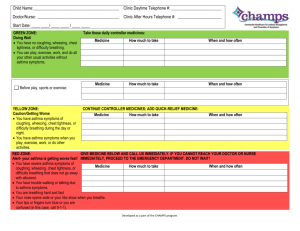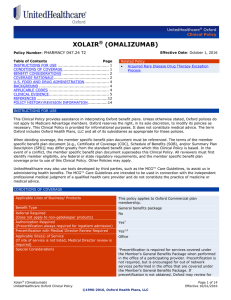Inner-City Asthma and Anti-IgE
advertisement

Inner-City Asthma and Anti-IgE William W. Busse, M.D. University of Wisconsin School of Medicine and Public Health Madison, WI, USA Disclosure Slide • Employment – University of Wisconsin • Financial Interests – Advisory Boards: Merck – Consultant: Amgen, Novartis, GlaxoSmithKline, MedImmune, Genentech • Data Monitoring Boards and Study Oversight Committees − Boston Scientific − Genentech − Icon • Research Interests – NHLBI, NIAID, • Organizational Interests – AAAAI, ATS, AAP, ACAAI, AAI, ACP, CIM • Gifts – Nothing to Disclose • Other Interests – Nothing to Disclose Why Focus on Inner City Asthma in Children and Adolescents? • Asthma is both more common and more severe in U.S. inner cities • High allergen loads – Cockroach – Mouse – House dust mite • Given the likely importance of allergen – IgE interactions to disease, particularly in the inner city, it was hypothesized that asthma control would improve by modulating IgE-dependent contributions to asthma Randomized Trial of Omalizumab (Anti-IgE) for Asthma in Inner-City Children. Busse WW, Morgan WJ, et al. N Engl J Med 2011; 364:1005-15 Enrollment characteristics • 6 to 20 years of age with a diagnosis of persistent asthma • Allergy to a perennial allergen • Inner-city resident • At recruitment, participants had uncontrolled asthma • Weight and total serum IgE levels were suitable for omalizumab dosing Study design • Enrollment (4 weeks) – asthma control assessed – using a guidelines-based algorithm, treatment was begun or adjusted to achieve asthma control • Randomization and treatment (60 weeks) – following an adjustment of asthma medications during enrollment, participants were randomized to receive omalizumab or placebo every 2–4 weeks for 60 weeks Asthma control of participants at enrollment (n=419) • Days of asthma symptoms the previous 2 weeks 4.9±4.2 • Childhood ACT® score in the last month (4–11 years) 18.9±4.1 • ACT® score (12 years and over) 18.8±4.2 • FEV1 (% predicted value) • FEV1/FVC 92.1±17.1 77.1±9.9 • ≥1 Hospitalization/past year 25% • ≥1 Unscheduled visit/ past year • Male subjects 78% 58% What were the effects of omalizumab on the number of days with asthma symptoms in the last 2 weeks? Difference of -0.48 day (p<0.001) (n=211) (n=208) Inhaled corticosteroids (budesonide equivalents) (mcg/day) What were the effects of omalizumab on the daily dose of inhaled corticosteroids (budesonide equivalents [µg/day])? Difference of -109 µg/day (p<0.001) (n=211) (n=208) What were the effects of omalizumab on exacerbations? Difference of -16.5% with an exacerbation (p<0.001) (n=211) (n=208) Asthma exacerbations also have seasonal patterns The September Epidemic of Asthma Exacerbations Johnston N et al, JACI 117:557-62, 2006 • Canadian asthma hospitalization admission data • Timing and magnitude of peaks in asthma hospitalization – 5-15 y/o children: 17.7 days after Labor Day – Preschoolers 1.7 days later – Adults 6.3 days later • Peak season for: – HRV – Some allergens (Alternaria, ragweed) Asthma Hospitalization Rates Ages 5-15 Yrs Johnston N, et al. JACI 117:557-62, 2006 % of Participants with Exacerbations What are the effects of omalizumab on the percentage of participants experiencing exacerbations over the year? (n=211) (n=208) The importance of IgE and allergic sensitization in virus-provoked asthma exacerbations Virus Cockroach Mast Cell Omalizumab X Exacerbation What role does IgE play in asthma exacerbations? Soto-Quiros et al. High titers of IgE antibody to dust mite allergen and risk for wheezing among asthmatic children infected with rhinovirus. J Allergy Clin Immunol 2012;129:1499-1505. • Evaluated the contribution of rhinovirus infections and atopic status to wheezing episodes in children (7 to 12 years old) in Costa Rica • 287 Children – 96 with acute wheezing – 65 stable asthma – 126 non-asthmatic control subjects Probability of current wheezing based on increasing titers of IgE antibodies to D pteronyssinus in children with negative test results for rhinovirus by using real-time PCR (A) compared with children with positive test results for rhinovirus (B). Soto-Quiros, et al. J Allergy Clin Immunol 2012;129:14991505. Does IgE affect interferon induction to rhinovirus and its replication? Baraldo et al. J Allergy Clin Immunol 2012; 130:1307-1314. Total Serum IgE Levels Baraldo et al. J Allergy Clin Immunol 2012; 130:1307-1314. What contribution does IgE make to a respiratory virus provoked asthma exacerbation? Elevated IgE Reduced IgE Exacerbation No Exacerbation Inflammation Virus Regulation Inflammation Virus Regulation Who are the candidates for the most favorable response to omalizumab? Hanania NA, et al. Am J Respir Crit Care Med 2013;187:804-811. Cockroach Sensitization & Exposure’s Effect on Omalizumab Efficacy What factors contribute to whether a respiratory infection provokes asthma and how might IgE fit into this process? Seed (Virus) Soil (Host) RV-subclasses (Class A and C) Allergic Inflammation Innate immune response + - Airway Hyperresponsiveness Inflammation Asthma Acknowledgements: Inner City Asthma Consortium • Investigators and sites – Wayne Morgan (University of Arizona) – George O’Connor (Boston University) – Jacqueline Pongracic (Northwestern, Children’s Memorial Hospital, Chicago – James Chmiel (Rainbow Babies & Children’s Hospital, Cleveland, OH) – Rebecca Gruchalla (University of Texas Southwestern Medical Center, Dallas, TX) – Andrew Liu (National Jewish Health, Denver, CO) – Meyer Kattan (Columbia University, New York) – Stephen Teach (Children’s National Medical Center, Washington, D.C.) • NIAID (Peter Gergen, Alkis Togias) • Rho; Statistical and Clinical Coordinating Center (Herman Mitchell, and Agustin Calatroni)








